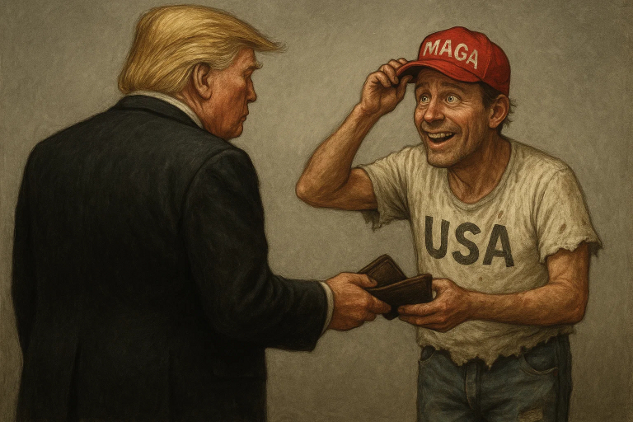
In This Article
- Why do citizens trade freedom for fear?
- How does authoritarianism exploit fear?
- What psychological forces drive voluntary surrender?
- How do media and propaganda reinforce this cycle?
- What can be done to reclaim liberty before it’s too late?
Freedom for Fear: Why Nations Are Trading Liberty for Authoritarian Promises
by Robert Jennings, InnerSelf.comSometimes, an image hits you in the gut because it strips away all the comforting lies we tell ourselves. We like to believe that freedom is something we would fiercely defend to the bitter end. But then along comes a stark visual reminder that surrender often happens not at the point of a gun but in the quiet moments when fear and loyalty cloud our judgment. A citizen, eyes wide with admiration, hands over his wallet to a leader devoid of human decency. No threat. No force. Just willing to surrender. It’s an uncomfortable truth: most freedoms are lost not through conquest but through consent.
And this is no isolated phenomenon. It’s a perfect metaphor for what is unfolding not only in America but around the world. The populist strongmen of our time understand a simple principle—why steal freedom when you can persuade people to give it away? Through relentless fearmongering, appeals to tribal loyalty, and promises of false security, they turn citizens into accomplices in their own undoing. The greatest trick of authoritarianism is not crushing resistance—it’s convincing the public there’s nothing worth resisting.
Trading Freedom for Fear: A Timeless Warning
Ben Franklin’s famous warning—those who trade liberty for temporary safety deserve neither—echoes louder today than ever. Fear is the oldest currency of authoritarianism. It requires no tanks or secret police at first; it seeps into hearts and minds, persuading citizens that danger lurks around every corner and that only a strong hand can keep them safe. When leaders stoke this fear, citizens often cling to promises of protection, blind to the cost. Once the bargain is struck—security in exchange for freedom—it rarely ends in the citizen’s favor.
History offers a grim catalog of these exchanges. The rise of fascism in 1930s Europe was built on the public terror of communism, unemployment, and social unrest—fears expertly manipulated by authoritarian leaders who promised order at the price of personal liberty. In America, the Red Scare of the 1950s saw careers destroyed and civil discourse throttled, all in the name of rooting out communist influence. More recently, the post-9/11 era ushered in a wave of security theater: sweeping surveillance programs, indefinite detentions, and erosions of privacy—many of which remain in place long after the immediate threat faded.
Now, the cycle repeats under the banner of nationalism and culture wars. Leaders inflame anxieties about immigration, racial justice, public health, and shifting cultural norms, framing these changes as existential threats to “our way of life.” In this climate of fear, too many citizens willingly trade freedom for the comforting illusion of control. It is a dangerous and familiar pattern—and as Franklin warned, the loss of liberty in such moments is not accidental. It is earned through surrender.
How Authoritarianism Exploits Fear
Authoritarian leaders understand one thing better than most: people will tolerate almost anything if they believe the alternative is worse. The first move is always to manufacture an existential threat—outsiders at the border, dissenters undermining unity, the press spreading “fake news,” or shadowy figures in the so-called “deep state.” Fear of the other creates a siege mentality, a mindset where compromise feels like treason, and vigilance becomes paranoia. Once the public is sufficiently unsettled, the strongman enters stage right, offering the oldest bargain in politics: surrender a few inconvenient freedoms, and in return, I will keep you safe.
But it never stops there. Authoritarianism is insatiable, a political black hole that draws in everything around it. Today, it’s freedom of speech under attack; tomorrow, freedom of assembly. Privacy is often sacrificed under the guise of national security, and eventually, even the sanctity of personal conscience is compromised. History shows that once citizens give in to this gravitational pull, the descent accelerates. By the time they realize how much they’ve lost, the machinery of repression is already well-oiled and running. And the leaders who promised to protect the people from fear now rely on fear itself to maintain control.
The Psychology of Voluntary Surrender
Why do people go along with it? The answer lies in psychology as much as politics. Fear triggers a primal response—fight, flight, or freeze. Authoritarians count on the freeze response. In the face of chaos and uncertainty, many seek comfort not in action but in submission. A population overwhelmed by anxiety often becomes passive, hoping that someone stronger will take charge and restore order. This is where the authoritarian steps in, offering straightforward answers and firm leadership at a time when ambiguity feels unbearable. The promise of safety—however illusory—becomes more appealing than the burden of freedom.
Add tribal identity to this psychological mix, and you have a potent brew. Loyalty to the leader morphs into allegiance to the tribe itself. Criticism is no longer seen as a civic duty but as a betrayal. Facts become malleable; trust shifts from independent institutions to the leader and their echo chamber. In this climate, citizens do not merely hand over their wallets—they surrender their voice, their rights, and ultimately, their moral compass. All of it is sacrificed for the comfort of belonging and the desperate hope that aligning with power will shield them from the chaos they so fear. And thus, liberty erodes—not through external conquest, but through internal collapse.
The Role of Media and Propaganda
Modern propaganda turbocharges this dynamic. Once upon a time, controlling the narrative required state-run media or overt censorship. Today’s authoritarians have a much more sophisticated—and insidious—toolkit. They exploit social media algorithms that reward outrage, cable news echo chambers that cater to ideological comfort zones, and a vast network of partisan influencers who blur the line between fact and fiction. Fear-based messaging spreads like wildfire in this environment, bypassing the brain’s rational filters and striking directly at the emotional core. The modern propaganda machine doesn’t need to silence dissent; it simply drowns it in a flood of fear and misinformation.
The message is relentless and depressingly effective: you are under attack, only we can save you; questioning us is dangerous. When repeated often enough, this narrative rewires the public’s perception of reality. People come to trust the voices of demagogues and media personalities more than their own eyes or long-standing democratic institutions. The result is a populace increasingly willing to trade freedom for fear, surrendering not only their civil liberties but their critical thinking. They do so not under duress but with applause—cheered on by a chorus of enablers who have mastered the dark art of manipulating the human need for safety and belonging.
Can We Break the Cycle?
Is there a way out of this downward spiral? Yes, but it requires facing uncomfortable truths. First, we must recognize that surrendering freedom out of fear is not patriotic—it is the opposite. Courage is not the absence of fear; it is choosing liberty despite fear. Second, we must rebuild trust—in institutions, in each other, and in the idea of democracy itself. That means pushing back against the purveyors of fear, refusing to let them define the narrative. It means lifting up leaders who inspire hope, not terror.
Finally, we must act. Freedom is not self-perpetuating; it must be defended anew by each generation. The price of liberty is eternal vigilance—not in the service of paranoia, but in the service of possibility. If we fail to meet that price, we will find ourselves like the man in the cartoon—wallet gone, rights gone, and freedom slipping through our fingers.
Music Interlude
About the Author
 Robert Jennings is the co-publisher of InnerSelf.com, a platform dedicated to empowering individuals and fostering a more connected, equitable world. A veteran of the U.S. Marine Corps and the U.S. Army, Robert draws on his diverse life experiences, from working in real estate and construction to building InnerSelf with his wife, Marie T. Russell, to bring a practical, grounded perspective to life’s challenges. Founded in 1996, InnerSelf.com shares insights to help people make informed, meaningful choices for themselves and the planet. More than 30 years later, InnerSelf continues to inspire clarity and empowerment.
Robert Jennings is the co-publisher of InnerSelf.com, a platform dedicated to empowering individuals and fostering a more connected, equitable world. A veteran of the U.S. Marine Corps and the U.S. Army, Robert draws on his diverse life experiences, from working in real estate and construction to building InnerSelf with his wife, Marie T. Russell, to bring a practical, grounded perspective to life’s challenges. Founded in 1996, InnerSelf.com shares insights to help people make informed, meaningful choices for themselves and the planet. More than 30 years later, InnerSelf continues to inspire clarity and empowerment.
Creative Commons 4.0
This article is licensed under a Creative Commons Attribution-Share Alike 4.0 License. Attribute the author Robert Jennings, InnerSelf.com. Link back to the article This article originally appeared on InnerSelf.com
books_denocracy
Article Recap
Freedom for fear is not just a personal choice—it is a national tragedy. As authoritarian surrender spreads through fear-driven politics, democracy itself stands at risk. Understanding how fear fuels this surrender is the first step toward restoring liberty and resisting authoritarianism.
#FreedomForFear #AuthoritarianSurrender #DemocracyUnderThreat #TradingFreedom #PoliticalFear #LibertyAndFear



